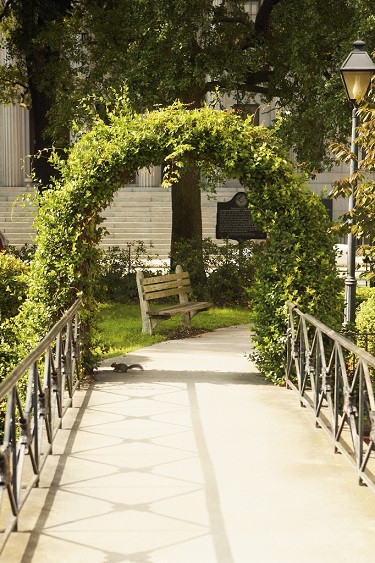Many gardeners have a limited amount of space to work with; be it an urban garden or a hobby greenhouse. Enthusiastic gardeners tend to quickly run out of space as well; usually because new species of plants are continually being added to the garden. No matter what the reason, as a horticulturist finds his or herself running out of space, it becomes important to maximize the space that is available. There are a variety of methods a gardener can use to make the most of their space. One technique is easy to implement and can help maximize production in the garden. It is called vertical gardening and it is exactly what it sounds like: growing upwards.
There are several ways a grower can use vertical gardening techniques in a greenhouse or outdoor garden. Some techniques are general and can be effective with a wide variety of plants, while others are better suited for specific crops. According to this article, vertical gardening has been used for over 5,000 years, in fact you may already be using a vertical gardening technique and not realize it. Vertical gardening techniques are commonly found in many types of gardens, including vegetable, purely aesthetic, and hydroponic gardens. A closer look at some of the common vertical gardening techniques can give a hobbyist a better understanding of what may work best in his or her garden.
Trellises

Trellises are a commonly used tool in gardens and can be made from wood, metal, plastic, or a variety of fabric materials, including cotton or nylon. Their purpose is to give a place for the gardener to “train” the plants and direct the plant’s growth. Many gardeners are familiar with the permanent wooden trellises commonly found in decorative gardens. Trellises can serve a vital function for vegetable gardeners by optimizing the crop’s yield. Trellises can do this in a few different ways. Some plants use tendrils (a specialized stem, leaf, or petiole used by climbing plants for support) to “grab” onto anything they can. Any gardener who has tried to separate cucumber plants that became entangled with each other can vouch for the strength and resilience of a plant’s tendrils. These specialized plant parts can cause anguish, but they can also make a gardener’s job easy, provided the grower uses the right tool for the job. Plants that naturally climb are great for trellises. In fact, combining trellises and climbing plants makes vertical gardening easy to achieve for any horticulturist. Trellises can be used on plants without tendrils as well. Cherry tomatoes are a great candidate for trellises. They tend to be fast-growing, lanky, and very bendable (in comparison to other types of tomatoes). Gardeners who take the time to weave cherry tomatoes through a trellis during the summer months will be rewarded with a wall of cherry tomatoes come harvest.
Tripods
Tripods, or teepees, are simple devices commonly found in vegetable gardens and are another type of vertical gardening technique that many people are already familiar with. Tripods are usually built from three long, narrow pieces of bamboo or wood tied together in a bunch at one end and spread into a triangle at the other end. Tripods can be used for a wide variety of plants but, like trellises, they are perfectly suited for plants that naturally climb. I switched my pole beans from trellises to tripods three years ago and I am glad I did. I like being able to space the base of the tripod to the exact spacing I need to give each plant enough room. Burying the bottom of each pole of the tripod gives the structure rigidity against the wind and weather. A gardener can bury each pole of the tripod by grabbing the base tightly with both hands and leaning their body weight on the pole to force it into the soil. This works best if the ends are slightly pointed. My pole beans have been highly productive since I switched to the tripods. Another reason I really like the tripod is because it is cheap (I built mine from sticks found in the woods). Tripods can also be used to support small tomato varieties and pepper plants by hanging a line of twine from the top center of the tripod down to the plant. As the plant grows, the twine can be wrapped around its stem to give support.
Fencing
Although fencing is usually used to secure the perimeter of the garden, in some cases, it can also be used as a way to implement vertical gardening techniques. If ridged fencing is being used around the garden, the fencing may be able to double as a trellis for vertical gardening. Just remember, anything that grows outside the fence line may end up being nibbled. Many urban growers are increasing their gardening space by using the fencing that lines the perimeter of the yard. Hanging planter boxes or DIY hydroponic systems on backyard fences are forms of vertical gardening that are growing in popularity.
Shelving Structures
Greenhouse shelving is one of the most common examples of vertical gardening currently being used. By using shelving in a greenhouse, the horticulturist automatically gains “floor space”. Multiple tier shelving can give greenhouse growers the ability to maximize the vertical space of their greenhouses. Some shelving structures that are typically designed to be used outside can resemble a pyramid. These pyramid shelving structures are not only aesthetically pleasing but can also be very functional. Each of the tiers can contain its own garden bed, allowing a gardener to create a fountain of vibrant plant growth in his or her own backyard.
Vertical Planters
There are many manufactured vertical planters on the market or DIY ideas that can help a gardener implement vertical growing techniques. These planters can be as simple as a 55 gallon drum with alternating holes punched on the sides or as elaborate as a manufactured planter. Whether growers make vertical planters themselves or purchase a pre-made unit, the function is the same: to maximize the gardening area by growing upwards. Many vertical garden planters are an excellent choice for lettuces, other greens, or strawberries as they maximize the space and also lift the plant from ground level. By lifting plants off the ground, some of the damage from common pests, like rabbits, slugs, and snails, can be reduced or eliminated.
Vertical Hydroponic Systems
Many of the most efficient hydroponic systems are, in fact, vertical hydroponic systems. Like other vertical gardening techniques, these hydroponic systems maximize the given floor space. Most vertical hydroponic systems offer an additional advantage: maximizing the use of water and the nutrient solution. Most vertical hydroponic systems are set up so the highest plants receive the solution first and then gravity brings the solution down to the next level of plants and so on until the solution is returned to the reservoir or drained to waste. Many vertical hydroponic systems are recirculating systems which makes them that much more efficient in terms of water and nutrient usage. Gutters, tubes, buckets, or customized containers are all commonly used in vertical hydroponic systems.
Things to Consider
Like other newly implemented techniques in a garden or greenhouse, there are a few issues to consider before using any of these vertical gardening techniques. Before using a vertical garden, plant placement in the garden and the direction of the incoming light should be considered because many of these techniques could shade out other areas of the garden or greenhouse. Generally speaking, it is best to place vertical growing structures on the north side of the garden so that other precious growing space isn’t shaded and lost. The weight of the soil and the plants as they grow is another matter to consider. Planting containers and hydroponic systems are easy to hang from fencing and other structures prior to being filled with soil or water but may be difficult to maneuver when they are at their maximum weight capacity. When making calculations, it is always better to overcompensate so that the vertical garden is as safe as it is enjoyable.
Growing vertically is one of the best ways a horticulturist can maximize space and production of his or her garden. Do not be afraid to experiment with a variety of these techniques until you find which is best suited for your gardening needs. In some cases, implementing multiple vertical gardening techniques is the best way to optimize the growth in the garden. During the experimentation it may be discovered that particular crops do better with one type of vertical gardening verses another. Most importantly, enjoy the process. It turns out growing up can be rewarding and fun after all.
Eric Hopper resides in Michigan’s beautiful Upper Peninsula where he enjoys gardening and pursuing sustainability.
Related Articles & Free Email Newsletter Sign Up
The Good and Bad of Vertical Gardens
Vertical Gardening for Beginners
Vertical Gardens Can Grow a Lot in a Small Space




Comment here